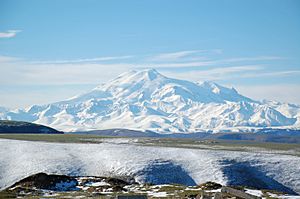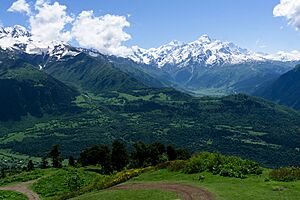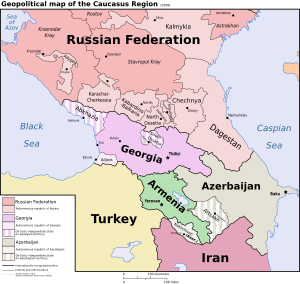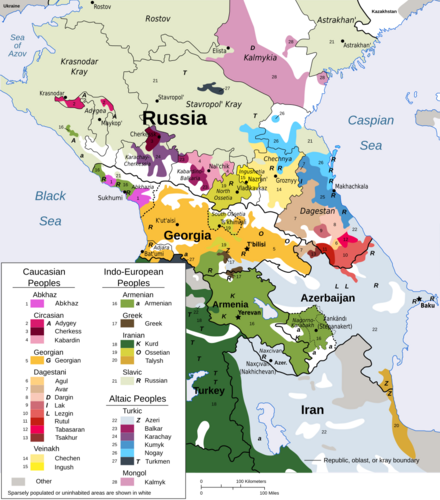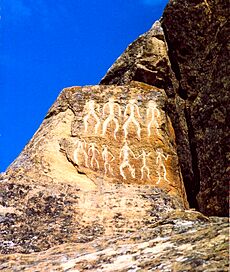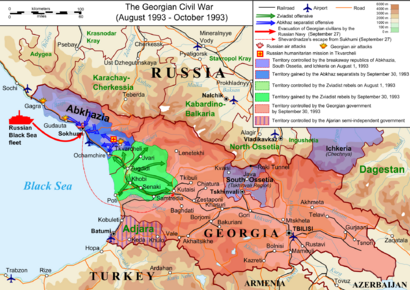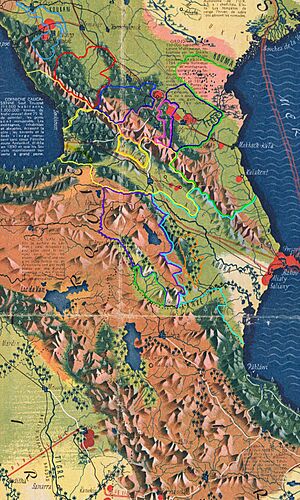Caucasus facts for kids
Quick facts for kids Caucasus |
|
|---|---|

Topography of the Caucasus
|
|
| Coordinates | 42°15′40″N 44°07′16″E / 42.26111°N 44.12111°E |
| Countries | |
| Autonomous republics and federal regions |
|
| Demonym | Caucasian |
| Time Zones | UTC+03:00, UTC+03:30 and UTC+04:00 |
| Highest mountain | Elbrus (5,642 metres (18,510 ft)) |
The Caucasus or Caucasia is a large region. It connects Eastern Europe and Western Asia. You can find it between the Black Sea and the Caspian Sea. This area includes countries like Armenia, Azerbaijan, Georgia, and parts of Southern Russia.
The Caucasus Mountains are a natural border. They separate Europe from Asia. Mount Elbrus, the highest mountain in Europe, is in the Russian part of the Caucasus. To the south, the Lesser Caucasus mountains include the Javakheti Plateau and the Armenian highland. Some parts of these highlands are in Turkey.
The Caucasus is split into two main parts: the North Caucasus and the South Caucasus. The Greater Caucasus mountain range is mostly in Russia and Georgia. It also touches the northern parts of Azerbaijan. The Lesser Caucasus mountains are in the south. They are home to Armenia, Azerbaijan, and Georgia. They also stretch into northeastern Turkey and northern Iran.
This region is famous for its many different languages. Besides languages like English or Turkish, there are unique language families. These include Kartvelian, Northwest Caucasian, and Northeast Caucasian languages. They have been spoken here for a very long time.
Contents
Understanding the Name "Caucasus"
Have you ever wondered where the name Caucasus comes from? Ancient writers had some ideas. Pliny the Elder, a Roman writer, thought it came from a Scythian word. This word, Croucasis, might have meant 'shimmering with snow'. Another old writer, Isidore of Seville, also said the name meant 'shining white like snow'.
Some experts think the name comes from an ancient Greek word. This word, Kaúkasos, could mean 'mountain of the seagull(s)'. In Georgian stories, the name comes from a legendary ancestor named Caucas. Other ideas connect it to words meaning 'high' or 'hill'.
Exploring the Caucasus Region
The word Caucasus doesn't just mean the mountains. It also includes the lands around them. These are called Ciscaucasia (in Russia) and Transcaucasia. The Transcaucasia region was once a border area for ancient empires. These included the Parthian and Sasanian Empires.
Some old stories say the mythical Mount Qaf was in this region. This mountain was believed to be the world's highest. It was a place of mystery in ancient Iranian tales.
Political Map of the Caucasus
The Caucasus region has two main political parts. The North Caucasus is also known as Ciscaucasus. It includes most of the Greater Caucasus mountains. This area is part of Southern Russia. It has several self-governing republics and regions. These include Chechnya and Dagestan.
The South Caucasus is also called Transcaucasus. It borders the Greater Caucasus mountains to the north. To its west is the Black Sea and Turkey. To its east is the Caspian Sea. To its south is Iran. This area includes all of Armenia, most of Azerbaijan, and most of Georgia.
Some people believe the Greater Caucasus mountain range is the dividing line between Europe and Asia. If so, Mount Elbrus is Europe's highest point. Other ideas for the border include the Kuma-Manych Depression or the Kura and Rioni rivers.
The Caucasus is a very diverse place. It has many different languages, cultures, and landscapes. Today, the main countries in the Caucasus are Georgia, Azerbaijan, and Armenia. These countries became independent after the dissolution of the Soviet Union in 1991. The Russian Federation also has many parts in the North Caucasus.
Two areas in the region, Abkhazia and South Ossetia, have declared independence. However, most countries in the world still see them as part of Georgia.
People and Languages of the Caucasus
The Caucasus is home to over 50 different ethnic groups. This means there are many unique languages spoken here. Some language families are found only in this region. You can also hear Indo-European languages like Armenian and Russian. Turkic languages like Azerbaijani are also common. Russian is often used as a common language, especially in the North Caucasus.
Most people in the Caucasus are either Shia Muslims, Sunni Muslims, Eastern Orthodox Christians, or Armenian Christians.
A Brief History of the Caucasus
The Caucasus region has a long and exciting history. It sits between powerful neighbors like Turkey, Iran, and Russia. Because of this, it has often been a place where different empires met and sometimes fought. For many centuries, it was closely linked to the Iranian world.
Ancient Times
People have lived in the Caucasus for a very long time. Scientists found ancient human fossils in Georgia. These fossils are about 1.8 million years old! They are some of the oldest signs of early humans found outside of Africa.
Later, ancient kingdoms like Armenia and Georgia grew in the region. These kingdoms were often part of larger Iranian empires. Zoroastrianism was a major religion here in the first century BC. The Roman Empire also became involved, leading to many conflicts with the Sasanian Empire for control of the region.
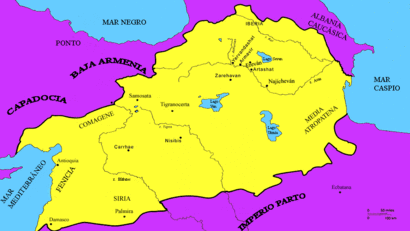
The Middle Ages

Christianity became very important in the Caucasus. Armenia was one of the first nations to adopt Christianity as its official religion in 301 AD. Later, Islam also spread into the region.
In the 12th century, the Georgian king David the Builder made Georgia a strong power. His armies pushed back invaders. Georgia became a leading Christian state in the Near East. It covered much of the Caucasus.
Over time, the region was also ruled by the Ottomans, Turco-Mongols, and local kingdoms. Iran also regained control at different times.
Modern Era Changes

In the early 1800s, the Russian Empire began to take control. They gained parts of the Southern Caucasus from the Persian Empire. Later, Russia conquered the North Caucasus too.
After the dissolution of the Soviet Union in 1991, Georgia, Azerbaijan, and Armenia became independent countries. Since then, there have been some disagreements over land. These have led to conflicts in areas like Nagorno-Karabakh and Abkhazia.
Myths and Legends of the Caucasus
The Caucasus is a place rich in ancient stories and myths. In Greek mythology, the Caucasus was a giant pillar holding up the world. It's where Prometheus was chained for giving fire to humans. An eagle would peck at his liver every day as punishment. In Georgian myths, a hero named Amirani has a similar story.
Persian mythology links the Caucasus to the mythical Mount Qaf. This mountain was said to surround the world. It was also a place for heroes and magical creatures.
The Roman poet Ovid described the Caucasus as a cold, rocky mountain. It was home to personified hunger. The Greek hero Jason also sailed to the Caucasus. He was looking for the Golden Fleece and met Medea there.
Later Folklore and Connections
The Caucasus has many amazing folktales. These stories were passed down by word of mouth for centuries. They include the Nart sagas. These tales are about ancient heroes called the Narts. Characters like Satanaya, the Nart mother, and Sosruquo, a trickster, appear in these stories.
Many Caucasian legends are similar to ancient Greek myths. For example, the goddess Satanaya is like the Greek goddess Aphrodite. The story of Sosruquo becoming invulnerable is like the Greek hero Achilles. There are also stories about giants. These giants are often one-eyed shepherds who live in caves. They are tricked and blinded by heroes, just like Homer's Polyphemus.
The Prometheus story is also very popular here. Many legends feature a giant hero who fights with gods. He steals fire for humans and is then chained and tormented by a bird. The Adyge Nart Nasran and the Georgian Amirani are examples of such heroes.
Nature and Wildlife in the Caucasus
The Caucasus is a very important place for nature. It's considered one of the world's 34 "biodiversity hotspots." This means it has a huge variety of plants and animals. There are about 6,400 types of plants here. About 1,600 of these are found nowhere else in the world!
The wildlife includes amazing animals like Persian leopards, brown bears, wolves, and bison. You can also see golden eagles flying high. The mountains are also home to a special dog breed, the Caucasian Shepherd Dog.
This region has many unique species. Some plants and animals here are "relicts." This means they survived the last Ice Age in the Caucasus Mountains. The Caucasus forests were a safe place for them. This area is very special for scientists studying nature.
Resources and Economy
The Caucasus region is rich in natural resources. It has many important minerals. These include gold, silver, copper, and iron ore. It also has a lot of energy resources. You can find oil, natural gas, and coal here. These resources are important for the economies of the countries in the region.
Sports and Fun in the Caucasus
The Caucasus mountains are great for winter sports. Places like Gudauri in Georgia are popular for skiing and paragliding. Krasnaya Polyana in Russia is also a famous ski and snowboard center.
The region has hosted many exciting sports events. Azerbaijan held the first 2015 European Games. It also hosted the Azerbaijan Grand Prix for Formula One racing. Georgia has hosted rugby and football championships. Armenia hosted the UEFA European Under-19 Championship in 2019.
See also
- Caucasian cuisine
- Culture of Armenia
- Culture of Azerbaijan
- Culture of Georgia (country)
- Eastern Partnership
- Eurasian Economic Union
- Regions of Europe
- Tourism in Armenia
- Tourism in Azerbaijan
- Tourism in Georgia
- Tourism in Russia
 In Spanish: Cáucaso para niños
In Spanish: Cáucaso para niños


